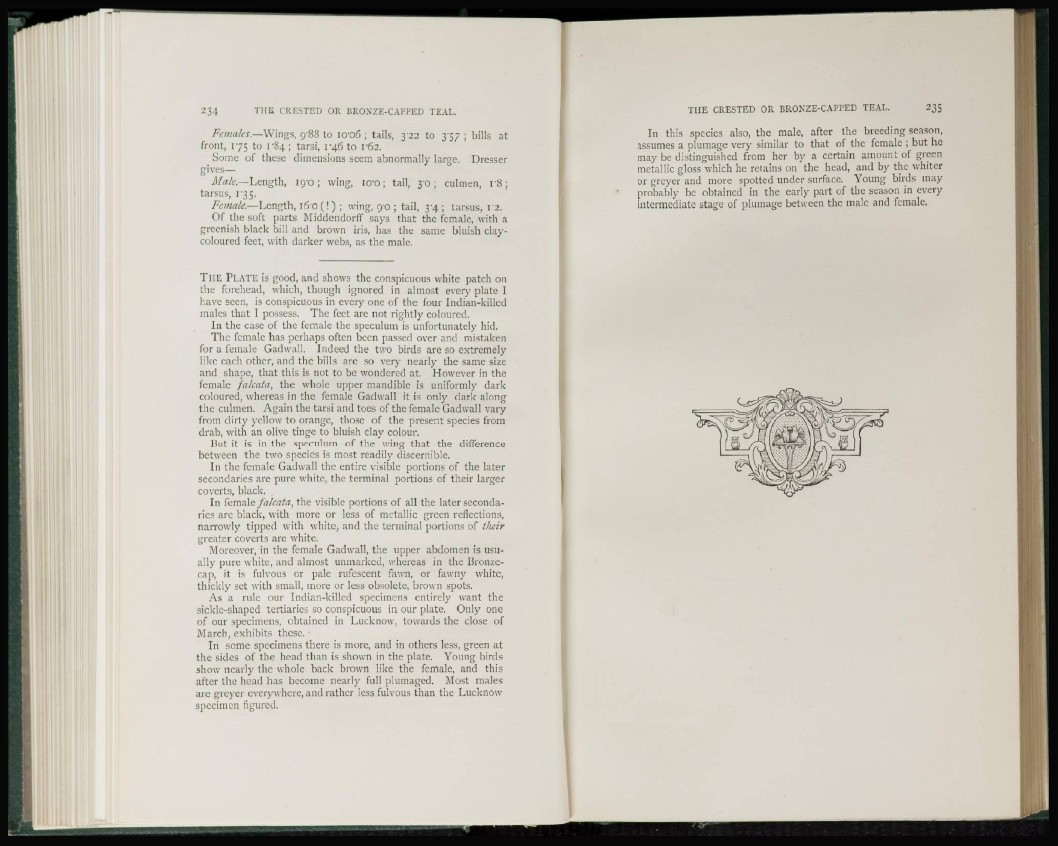
Females.—Wings, 9/88 to 1006 ; tails, 322 to 3'57 ; bills at
front, 175 to 1'84 ; tarsi, 1-46 to 1-62.
Some of these dimensions seem abnormally large. Dresser
g i v e s—
Male.—Length, I9'0 ; wing, IO'O; tail, 3'0 ; culmen, 1 8;
tarsus, 1'3 5.
Female.—Length, 160 (! ) ; wing, 90 ; tail, 34. ; tarsus, 12.
Of the soft parts Middcndorff says that the female, with a
greenish black bill and brown iris, has the same bluish claycoloured
feet, with darker webs, as the male.
THE PLATE is good, and shows the conspicuous white patch on
the forehead, which, though ignored in almost every plate I
have seen, is conspicuous in every one of the four Indian-killed
males that I possess. The feet are not rightly coloured.
In the case of the female the speculum is unfortunately hid.
The female has perhaps often been passed over and mistaken
for a female Gadwall. Indeed the two birds are so extremely
like each other, and the bills are so very nearly the same size
and shape, that this is not to be wondered at. However in the
female falcata, the whole upper mandible is uniformly dark
coloured, whereas in the female Gadwall it is only dark along
the culmen. Again the tarsi and toes of the female Gadwall vary
from dirty yellow to orange, those of the present species from
drab, with an olive tinge to bluish clay colour.
But it is in the speculum of the wing that the difference
between the two species is most readily discernible.
In the female Gadwall the entire visible portions of the later
secondaries are pure white, the terminal portions of their larger
coverts, black.
In female falcata, the visible portions of all the later secondaries
arc black, with more or less of metallic green reflections,
narrowly tipped with white, and the terminal portions of their
greater coverts are white.
Moreover, in the female Gadwall, the upper abdomen is usually
pure white, and almost unmarked, whereas in the Bronzecap,
it is fulvous or pale rufescent fawn, or fawny white,
thickly set with small, more or less obsolete, brown spots.
As a rule our Indian-killed specimens entirely want the
sickle-shaped tertiaries so conspicuous in our plate. Only one
of our specimens, obtained in Lucknow, towards the close of
March, exhibits these.
In some specimens there is more, and in others less, green at
the sides of the head than is shown in the plate. Young birds
show nearly the whole back brown like the female, and this
after the head has become nearly full plumaged. Most males
are greyer everywhere, and rather less fulvous than the Lucknow
specimen figured.
In this species also, the male, after the breeding season,
assumes a plumage very similar to that of the female ; but he
may be distinguished from her by a certain amount of green
metallic gloss which he retains on the head, and by the whiter
or greyer and more spotted under surface. Young birds may
probably be obtained in the early part of the season in every
intermediate stage of plumage between the male and female.